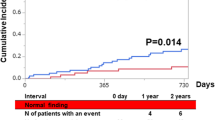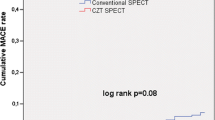Abstract
Background
The role of single photon emission computed tomography myocardial perfusion imaging (SPECT MPI) in cardiac evaluation of the very elderly patients is unclear. We investigated the clinical value of SPECT MPI in very elderly patients (≥80 years) with suspected coronary artery disease (CAD) as well as in comparison to younger patients.
Methods and Results
A retrospective analysis of prospectively collected data from 8,864 patients [1,093 patients ≥80 years (very elderly), 3,369 patients 65-79 years (elderly), and 4,402 patients 50-64 years (middle-aged)] with suspected CAD who underwent exercise and/or pharmacologic stress testing with SPECT MPI between 1996 and 2005 was performed. Clinical and SPECT MPI characteristics, cardiac event rates, early (≤60 days) cardiac catheterization and revascularization rates of very elderly patients were compared to that of younger patients. Mean follow-up for cardiac events (cardiac death or non-fatal myocardial infarction) was 1.9 ± 0.9 years. Very elderly patients with moderate to severely abnormal SSS had a significantly higher annualized cardiac event rate than those with mildly abnormal or normal study (9.6% vs 3.4% and 2.5% respectively, P < .001). Across all categories of SSS, very elderly patients had a significantly higher cardiac event rate as compared to younger patients (P < .001). Early cardiac catheterization and revascularization referrals in very elderly patients increased as a function of severity of ischemia on SPECT MPI (P < .001), although these referral rates were significantly lower in very elderly patients with mild to moderate and severe ischemia as compared to younger patients (P < .05).
Conclusions
In very elderly patients (≥80 years) with suspected CAD, SPECT MPI has prognostic and incremental value in the noninvasive cardiovascular assessment for risk stratification and may influence medical decisions.








Similar content being viewed by others
References
American Heart Association. Heart Disease and Stroke Statistics-2009 Update. Dallas, TX: American Heart Association; 2009.www.americanheart.org. Accessed January 2010.
Kannel WB, Vokonas PS. Demographics of the prevalence, incidence, and management of coronary heart disease in the elderly and in women. Ann Epidemiol 1992;2:5-14.
Foot DK, Lewis RP, Pearson TA, Beller GA. Demographics and cardiology, 1950-2050. J Am Coll Cardiol 2000;35:1067-81.
TIME Investigators. Trial of invasive versus medical therapy in elderly patients with chronic symptomatic coronary-artery disease (TIME): A randomised trial. Lancet 2001;358:951-7.
Aronow WS. Silent MI. Prevalence and prognosis in older patients diagnosed by routine electrocardiograms. Geriatrics 2003;58:24-8, 40
Tresch DD, Alla HR. Diagnosis and management of myocardial ischemia (angina) in the elderly patient. Am J Geriatr Cardiol 2001;10:337-44.
Shaw LJ, Narula J. Risk assessment and predictive value of coronary artery disease testing. J Nucl Med 2009;50:1296-306.
Shaw LJ, Iskandrian AE. Prognostic value of gated myocardial perfusion SPECT. J Nucl Cardiol 2004;11:171-85.
Perrone-Filardi P, Costanzo P, Dellegrottaglie S, Gargiulo P, Ruggiero D, Savarese G, et al. Prognostic role of myocardial single photon emission computed tomography in the elderly. J Nucl Cardiol 2010;17:310-5.
Curtis JP, Ko DT, Wang Y, Wackers FJ, Foody JM. The prognostic value of vasodilator myocardial perfusion imaging in octogenarians. Am J Geriatr Cardiol 2004;13:239-45.
Hachamovitch R, Kang X, Amanullah AM, Abidov A, Hayes SW, Friedman JD, et al. Prognostic implications of myocardial perfusion single-photon emission computed tomography in the elderly. Circulation 2009;120:2197-206.
Zafrir N, Mats I, Solodky A, Ben-Gal T, Sulkes J, Battler A. Prognostic value of stress myocardial perfusion imaging in octogenarian population. J Nucl Cardiol 2005;12:671-5.
Zafrir N, Mats I, Solodky A, Ben-Gal T, Battler A. Characteristics and outcome of octogenarian population referred for myocardial perfusion imaging: Comparison with non-octogenarian population with reference to gender. Clin Cardiol 2006;29:117-20.
American Society of Nuclear Cardiology. Updated imaging guidelines for nuclear cardiology procedures, part 1. J Nucl Cardiol 2001;8:G5–58.
Gibbons RJ, Balady GJ, Bricker JT, Chaitman BR, Fletcher GF, Froelicher VF, et al. ACC/AHA 2002 guideline update for exercise testing: Summary article. A report of the American College of Cardiology/American Heart Association Task Force on Practice Guidelines (Committee to Update the 1997 Exercise Testing Guidelines). J Am Coll Cardiol 2002;40:1531-40.
Klocke FJ, Baird MG, Lorell BH, Bateman TM, Messer JV, Berman DS, et al. ACC/AHA/ASNC guidelines for the clinical use of cardiac radionuclide imaging-executive summary: A report of the American College of Cardiology/American Heart Association Task Force on Practice Guidelines (ACC/AHA/ASNC Committee to Revise the 1995 Guidelines for the Clinical Use of Cardiac Radionuclide Imaging). Circulation 2003;108:1404-18.
Jette M, Sidney K, Blumchen G. Metabolic equivalents (METS) in exercise testing, exercise prescription, and evaluation of functional capacity. Clin Cardiol 1990;13:555-65.
Henzlova MJ, Cerqueira MD, Mahmarian JJ, Yao SS. Stress protocols and tracers. J Nucl Cardiol 2006;13:e80-90.
American Society of Nuclear Cardiology. Imaging guidelines for nuclear cardiology procedures, part 2. J Nucl Cardiol 1999;6:G47-84.
Cerqueira MD, Weissman NJ, Dilsizian V, Jacobs AK, Kaul S, Laskey WK, et al. Standardized myocardial segmentation and nomenclature for tomographic imaging of the heart: A statement for healthcare professionals from the Cardiac Imaging Committee of the Council on Clinical Cardiology of the American Heart Association. Circulation 2002;105:539-42.
Hachamovitch R, Berman DS, Shaw LJ, Kiat H, Cohen I, Cabico JA, et al. Incremental prognostic value of myocardial perfusion single photon emission computed tomography for the prediction of cardiac death: Differential stratification for risk of cardiac death and myocardial infarction. Circulation 1998;97:535-43.
Sharir T, Germano G, Kang X, Lewin HC, Miranda R, Cohen I, et al. Prediction of myocardial infarction versus cardiac death by gated myocardial perfusion SPECT: Risk stratification by the amount of stress-induced ischemia and the poststress ejection fraction. J Nucl Med 2001;42:831-7.
McClellan JR, Travin MI, Herman SD, Baron JI, Golub RJ, Gallagher JJ, et al. Prognostic importance of scintigraphic left ventricular cavity dilation during intravenous dipyridamole technetium-99m sestamibi myocardial tomographic imaging in predicting coronary events. Am J Cardiol 1997;79:600-5.
Weiss AT, Berman DS, Lew AS, Nielsen J, Potkin B, Swan HJ, et al. Transient ischemic dilation of the left ventricle on stress thallium-201 scintigraphy: A marker of severe and extensive coronary artery disease. J Am Coll Cardiol 1987;9:752-9.
Germano G, Kiat H, Kavanagh PB, Moriel M, Mazzanti M, Su HT, et al. Automatic quantification of ejection fraction from gated myocardial perfusion SPECT. J Nucl Med 1995;36:2138-47.
Heron M, Hoyert DL, Murphy SL, Xu J, Kochanek KD, Tejada-Vera B. Deaths: Final data for 2006. Natl Vital Stat Rep 2009;57:1-134.
Sadeghi HM, Grines CL, Chandra HR, Dixon SR, Boura JA, Dukkipati S, et al. Percutaneous coronary interventions in octogenarians. Glycoprotein IIb/IIIa receptor inhibitors’ safety profile. J Am Coll Cardiol 2003;42:428-32.
Navare SM, Mather JF, Shaw LJ, Fowler MS, Heller GV. Comparison of risk stratification with pharmacologic and exercise stress myocardial perfusion imaging: A meta-analysis. J Nucl Cardiol 2004;11:551-61.
Brown KA, Altland E, Rowen M. Prognostic value of normal technetium-99m-sestamibi cardiac imaging. J Nucl Med 1994;35:554-7.
Iskander S, Iskandrian AE. Risk assessment using single-photon emission computed tomographic technetium-99m sestamibi imaging. J Am Coll Cardiol 1998;32:57-62.
Stratmann HG, Williams GA, Wittry MD, Chaitman BR, Miller DD. Exercise technetium-99m sestamibi tomography for cardiac risk stratification of patients with stable chest pain. Circulation 1994;89:615-22.
Amanullah AM, Kiat H, Hachamovitch R, Cabico JA, Cohen I, Friedman JD, et al. Impact of myocardial perfusion single-photon emission computed tomography on referral to catheterization of the very elderly. Is there evidence of gender-related referral bias? J Am Coll Cardiol 1996;28:680-6.
Baskett R, Buth K, Ghali W, Norris C, Maas T, Maitland A, et al. Outcomes in octogenarians undergoing coronary artery bypass grafting. CMAJ 2005;172:1183-6.
Fuchs S, Stabile E, Kinnaird TD, Mintz GS, Gruberg L, Canos DA, et al. Stroke complicating percutaneous coronary interventions: Incidence, predictors, and prognostic implications. Circulation 2002;106:86-91.
Kinnaird TD, Stabile E, Mintz GS, Lee CW, Canos DA, Gevorkian N, et al. Incidence, predictors, and prognostic implications of bleeding and blood transfusion following percutaneous coronary interventions. Am J Cardiol 2003;92:930-5.
Boden WE, O’Rourke RA, Teo KK, Hartigan PM, Maron DJ, Kostuk WJ, et al. Optimal medical therapy with or without PCI for stable coronary disease. N Engl J Med 2007;356:1503-16.
Henderson RA, Pocock SJ, Clayton TC, Knight R, Fox KA, Julian DG, et al. Seven-year outcome in the RITA-2 trial: Coronary angioplasty versus medical therapy. J Am Coll Cardiol 2003;42:1161-70.
Hueb WA, Soares PR, Meida De OS, Arie S, Cardoso RH, Wajsbrot DB, et al. Five-year follow-op of the medicine, angioplasty, or surgery study (MASS): A prospective, randomized trial of medical therapy, balloon angioplasty, or bypass surgery for single proximal left anterior descending coronary artery stenosis. Circulation 1999;100:107-13.
Gu K, Cowie CC, Harris MI. Diabetes and decline in heart disease mortality in US adults. JAMA 1999;281:1291-7.
Gregg EW, Gu Q, Cheng YJ, Narayan KM, Cowie CC. Mortality trends in men and women with diabetes, 1971 to 2000. Ann Intern Med 2007;147:149-55.
Mathur S, Shah AR, Ahlberg AW, Katten DM, Heller GV. Blunted heart rate response as a predictor of cardiac death in patients undergoing vasodilator stress technetium-99m sestamibi gated SPECT myocardial perfusion imaging. J Nucl Cardiol 2010;17:617-24.
Acknowledgment
We thank David O’Sullivan, PhD for his help in reviewing an earlier version of this manuscript.
Disclosures
None.
Author information
Authors and Affiliations
Corresponding author
Rights and permissions
About this article
Cite this article
Nair, S.U., Ahlberg, A.W., Mathur, S. et al. The clinical value of single photon emission computed tomography myocardial perfusion imaging in cardiac risk stratification of very elderly patients (≥80 years) with suspected coronary artery disease. J. Nucl. Cardiol. 19, 244–255 (2012). https://doi.org/10.1007/s12350-011-9477-6
Received:
Accepted:
Published:
Issue Date:
DOI: https://doi.org/10.1007/s12350-011-9477-6




